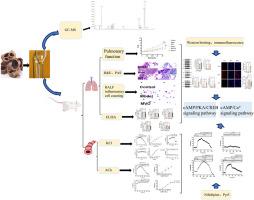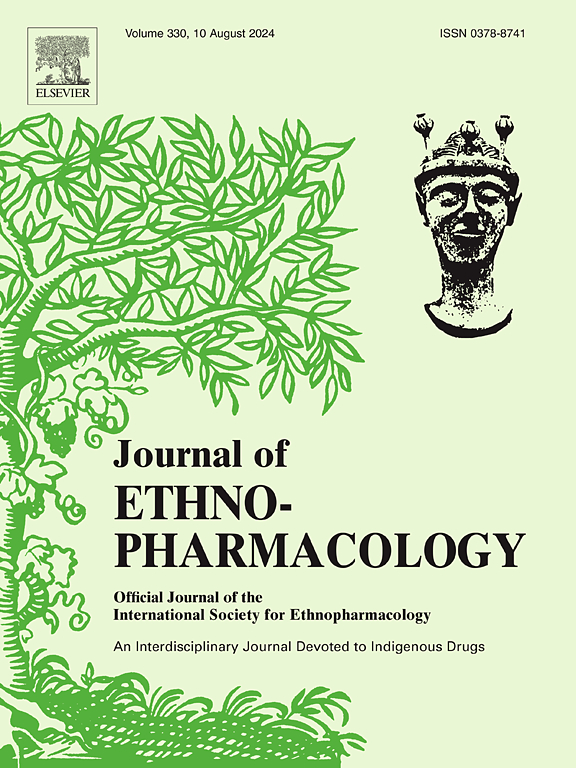Magnoliae Officinalis Cortex volatile oil alleviated asthma via dual cAMP-mediated pathways: Anti-Inflammation and Bronchodilation
IF 5.4
2区 医学
Q1 CHEMISTRY, MEDICINAL
引用次数: 0
Abstract
Ethnopharmacological relevance
Magnoliae Officinalis Cortex, a commonly used Chinese medicinal herb, has a long history in traditional East Asian medicine and is widely employed in the treatment of gastrointestinal disorders, asthma, depression, and other ailments. However, the potential of volatile oil derived from the bark of Magnolia officinalis Cortex (MVO) in asthma treatment remains to be determined.
Aim of the study
This study aimed to explore the therapeutic effect of MVO on asthma and to explore its pathway and molecular mechanism under cAMP signal background.
Methods
This study combined GC-MS with in vivo and in vitro experiments to elucidate the anti-asthmatic mechanism of MVO. An OVA-induced asthma model was established to evaluate the therapeutic effect of MVO via pulmonary function tests, H&E, BALF inflammatory cell counting, and ELISA. Fluo-4 AM, immunofluorescence and WB were further used to explore the underlying mechanism. In vitro, isolated tracheal rings were used as the object, and contraction models were constructed with KCl and acetylc holine to observe the relaxatory effect of MVO. Nifedipine (an L-type calcium channel blocker) and Pyr3 (a TRPC3 channel inhibitor) were used to intervene in the calcium signaling pathway, and the involvement of the cAMP pathway was analyzed by detecting cAMP level.
Results
GC-MS analysis identified high concentrations of α-eudesmol, β-eudesmol, γ-eudesmol, and o-cymene in MVO. In vivo experiments showed that MVO reduced OVA-induced inflammatory cell infiltration and mucus secretion, improved pulmonary function, decreased Th2-type cytokines in BALF and serum IgE level, up-regulated the level of cAMP and the expressions of p-PKA/p-CREB in lung tissues, and inhibited NF-κB activation, reducing Ca2+ level and membrane localization in lung tissues. In vitro experiments showed that MVO could relax tracheal smooth muscle contractions induced by KCl and ACh in a dose-dependent manner. Application of nifedipine and Pyr3 confirmed that MVO exerted its relaxant effect by blocking L-VDCC and NSCC/TRPC channels.
Conclusion
MVO attenuated airway hyperresponsiveness by modulating the cAMP/PKA/CREB pathway, which subsequently suppressed NF-κB-driven inflammatory responses, while concurrently restoring cAMP/Ca2+ homeostasis. Significantly, our study demonstrated a novel dual-action therapeutic strategy targeting cAMP for asthma, bridging bronchodilatory and anti-inflammatory effects.

厚朴挥发油通过camp介导的双通路:抗炎和支气管扩张缓解哮喘。
民族药理学相关性:厚朴是一种常用的中草药,在东亚传统医学中有着悠久的历史,被广泛用于治疗胃肠道疾病、哮喘、抑郁症和其他疾病。然而,厚朴皮(MVO)挥发油在哮喘治疗中的潜力仍有待确定。研究目的:本研究旨在探讨MVO在cAMP信号背景下对哮喘的治疗作用,探讨其通路和分子机制。方法:采用气相色谱-质谱联用法和体内外实验相结合的方法,探讨MVO的抗哮喘作用机制。建立ova诱导的哮喘模型,通过肺功能、H&E、BALF炎症细胞计数及ELISA评价MVO的治疗效果。Fluo-4 AM、免疫荧光和WB进一步探讨其潜在机制。体外以离体气管环为对象,用KCl和乙酰胆碱构建收缩模型,观察MVO的舒张作用。采用硝苯地平(l型钙通道阻滞剂)和Pyr3 (TRPC3通道抑制剂)干预钙信号通路,通过检测cAMP水平分析cAMP通路的参与情况。结果:气相色谱-质谱分析发现MVO中含有高浓度的α-桉树酚、β-桉树酚、γ-桉树酚和o-花香烃。体内实验表明,MVO可减少ova诱导的炎症细胞浸润和粘液分泌,改善肺功能,降低BALF中th2型细胞因子和血清IgE水平,上调肺组织cAMP水平和p-PKA/p-CREB表达,抑制肺组织NF-κB活化,降低肺组织Ca2+水平和膜定位。体外实验表明,MVO对KCl和ACh诱导的气管平滑肌收缩具有剂量依赖性。硝苯地平和Pyr3的应用证实MVO通过阻断L-VDCC和NSCC/TRPC通道发挥松弛作用。结论:MVO通过调节cAMP/PKA/CREB通路减轻气道高反应性,随后抑制NF-κ b驱动的炎症反应,同时恢复cAMP/Ca2+稳态。值得注意的是,我们的研究展示了一种新的双作用治疗策略,针对cAMP治疗哮喘,桥接支气管扩张和抗炎作用。
本文章由计算机程序翻译,如有差异,请以英文原文为准。
求助全文
约1分钟内获得全文
求助全文
来源期刊

Journal of ethnopharmacology
医学-全科医学与补充医学
CiteScore
10.30
自引率
5.60%
发文量
967
审稿时长
77 days
期刊介绍:
The Journal of Ethnopharmacology is dedicated to the exchange of information and understandings about people''s use of plants, fungi, animals, microorganisms and minerals and their biological and pharmacological effects based on the principles established through international conventions. Early people confronted with illness and disease, discovered a wealth of useful therapeutic agents in the plant and animal kingdoms. The empirical knowledge of these medicinal substances and their toxic potential was passed on by oral tradition and sometimes recorded in herbals and other texts on materia medica. Many valuable drugs of today (e.g., atropine, ephedrine, tubocurarine, digoxin, reserpine) came into use through the study of indigenous remedies. Chemists continue to use plant-derived drugs (e.g., morphine, taxol, physostigmine, quinidine, emetine) as prototypes in their attempts to develop more effective and less toxic medicinals.
 求助内容:
求助内容: 应助结果提醒方式:
应助结果提醒方式:


